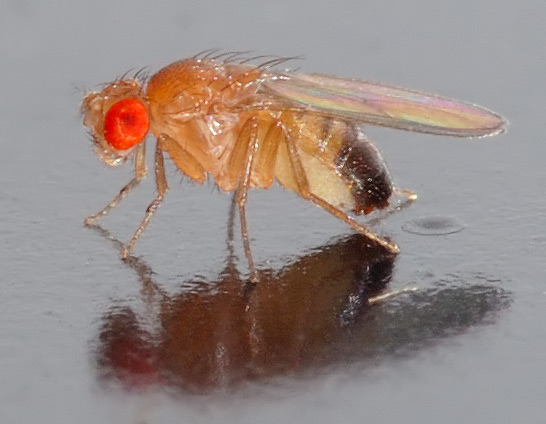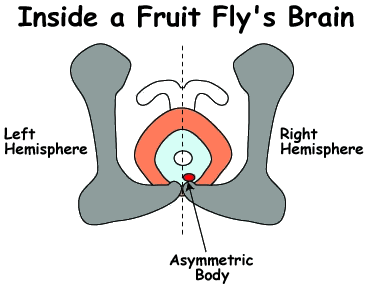The brain is probably the most fascinating yet impenetrable organ studied by scientists. One question that remains to be answered is why we have two halves to our brains, and are they the same? Indeed, you may have heard how different skills and behaviours can be attributed to "left brain" or "right brain" hemispheres. Furthermore the halves themselves are not physically identical. They are asymmetric (not symmetrical), with slightly different structures found in each side, although the basic design is the same. But is this asymmetry important? A team of scientists from France, led by Alberto Pascual, set out to probe this mental mystery.  First, the researchers had to choose an animal to study and found that the humble fruit fly, Drosophila melanogaster, fitted the bill for brain research. Fruit flies are not known for being the Einsteins of the animal kingdom, yet they have brains which are asymmetric like our own. Pascual and his team discovered a small lump inside the fruit fly brain that is only found in the right-hand hemisphere (see figure 1, below). They called this the "asymmetric body" (or AB, for short). By looking for the AB in over two and a half thousand fruit flies they discovered that nearly 8% of normal flies actually have symmetrical brains, with an AB in both their left and right brain halves. And yet these symmetrically-brained flies appeared to be completely normal in all other physical respects. So did their double-dose of AB have any effect on their brain function ?
First, the researchers had to choose an animal to study and found that the humble fruit fly, Drosophila melanogaster, fitted the bill for brain research. Fruit flies are not known for being the Einsteins of the animal kingdom, yet they have brains which are asymmetric like our own. Pascual and his team discovered a small lump inside the fruit fly brain that is only found in the right-hand hemisphere (see figure 1, below). They called this the "asymmetric body" (or AB, for short). By looking for the AB in over two and a half thousand fruit flies they discovered that nearly 8% of normal flies actually have symmetrical brains, with an AB in both their left and right brain halves. And yet these symmetrically-brained flies appeared to be completely normal in all other physical respects. So did their double-dose of AB have any effect on their brain function ?
To find out, the scientists put the flies through their paces in a series of rigorous tests. First the team probed the flies' short term memories by exposing them to a specific smell, followed by an electric shock. After three hours, the flies were tested again to see if they remembered the association between the smell and the shock. Meanwhile, to test long-term memory, another group of flies were individually put through an intensive teaching programme comprising five sessions of smell/shock training with 15-minute rest intervals between. This second group of flies were tested again after four days. From both the short-term and long-term memory tests, flies were separated according to whether they had remembered the association or not. The brains of these flies were then investigated to see if they had symmetric or asymmetric brains by looking for either two or one AB. The results were striking: the flies with symmetrical brains had no significant long-term memory, even though they performed acceptably on the short-term memory tests.
 |
| Figure 1 : Cross-section of a Drosophila brain. Although a fruit fly brain doesn't look much like one of our's, in common with a human brain it is divided into 2 halves (shown separated by a dotted line above). The location of the asymmetric body is shown in red. |
What can these forgetful flies tell us about how brains work? Of course, there needs to be much more research to figure out exactly why and how a symmetrical brain leads to long-term memory problems. The next step will be to look at more a complex brain, such as our own, to see if there is a similar link. Brain imaging technologies such as MRI and PET scanning provide the best tools with which to explore how brain structure is connected to functions like memory. It would also be interesting to look at patients with long-term memory problems, to see if they had more symmetrical brains than their less forgetful counterparts. In the future, we can hope to discover more about our brain of two halves, and maybe even explain why some people just can't remember birthdays!










Comments
Add a comment